
Desert plants bring striking beauty, resilience, and low-maintenance appeal to any landscape perfect for growing in hot, dry climates. As water scarcity becomes a growing concern, these drought-tolerant choices offer a sustainable solution. The Desert Southwest, which is expanding more quickly than the rest of the US, is seeing a large influx of new residents.
Ditch the water-guzzling lawn!. Instead, take cues from the desert itself. Desert plants are super tough and come in incredible shapes and colours. These plants create beautiful landscapes while using much less water than traditional gardens. Today, let’s explore the best 39 options for creating a dynamic desert-inspired landscape and bringing the intense beauty of the desert to your home. So, stay tuned till the end of my helpful post!.
TL; DR:
Quick Desert Planting Tips
- There is a gorgeous choice to complement your outdoor haven, ranging from eye-catching succulents to colorful floral species.
- Local wildlife, such as butterflies, bees, and birds, find refuge among desert plants. You’re establishing a healthy environment that sustains the regional food chain by planting them.
- Use ground coverings, architectural accents, and colorful native plants to add interest to your garden all year long.
- Create year-round interest in your garden with ground covers, architectural statements, and vibrant native plants.
- These plants boost soil health with deep roots that prevent erosion and add nutrients.
Understanding Desert Plants: Where Can They Grow?
Desert plants surprisingly thrive beyond their native habitats, growing well in USDA Hardiness Zones 7-11. Portland, OR, is a great example, where desert foliage flourishes despite the rainy climate, leveraging the dry summer months.
Key Growing Needs: These plants require excellent drainage to prevent root rot. They need well-draining soil, often mixed with pumice or coarse sand, and slightly alkaline to neutral pH levels.
Growth in Non-Desert Conditions: To succeed with desert plants in non-desert areas, recreate their natural habitat with:
- Plenty of sunlight
- Sharp drainage
- Minimal watering after establishment.
These basics help desert shrubberies thrive in various settings.
39 Must-Have Desert Plants for a Stunning, Low-Maintenance Garden
My folks! Now get ready to experience the beauty of the desert in your backyard with these must-have plants:
Succulents & Cacti: Iconic Desert Favorites
Let’s discover something cacti and prickly!
1. Golden Barrel Cactus (Echinocactus grusonii)
AKA: Mother-in-Law’s Cushion, Golden Ball Cactus and Golden Ball

Golden Barrel Cactus
Make a statement with golden barrel cactus!
This stunning cactus is a perfect addition to desert gardens. Its round shape and golden spines create a striking look. Use it as a focal point in rock gardens, group it for impact, or showcase it in large containers for a modern touch.
| Native to: | Central Mexico |
| Climate Regions: | Cold desert climate (BWk), Hot desert climate (BWh), Cold semi-arid climate (BSk), Hot semi-arid climate (BSh) |
| USDA Zones: | 9-11 |
| Pros: | This plant has a unique spherical shape, and is drought-tolerant, long-lived, and low-maintenance. |
| Considerations: | Be careful when placing this plant because it has sharp points. Also, be patient as it grows slowly. When introducing it to sunlight, do it gradually to prevent sunburn. |
2. Century Plant (Agave americana)
AKA: Maguey, American Aloe, Snake Plant, And American Century Plant

Century Plant
Want dramatic aesthetics in your yard?
Consider the Century Plant’s massive blue-gray leaves then! Perfect as a focal point or structural element in large desert gardens, its unique size and shape also make it a stunning addition to modern landscapes.
So why not try it?
| Native to: | Eastern Mexico |
| Climate Regions: | Thrives in Hot Desert (BWh) and Hot Semi-arid (BSh) climates. Can also grow in Cold Desert (BWk) and Cold Semi-arid (BSk) climates with proper winter protection. |
| USDA Zones: | 8-11 |
| Pros: | This desert plant is amazing! It has a cool shape, lives a long time, and comes in beautiful multicolored forms. Plus, it helps stop soil erosion. |
| Considerations: | It has sharp leaf tips, dies after flowering (which can take 10-30 years!), and can grow big – up to 6-8 feet wide! |
3. Aloe Vera (Aloe barbadensis miller)

Aloe Vera
AKA: True Aloe, Medicinal Aloe, Medicine Plant Burn Plant, and First Aid Plant
Aloe vera is a super addition to your desert garden! It’s a lovely plant in addition to being beneficial for healing. It grows in a way that makes it ideal for pots or margins, and its vivid green foliage gives colour.
| Native to: | Arabian Peninsula |
| Climate Regions:. | This plant loves hot desert and semi-desert climates. However, it can also thrive in colder desert and semi-desert regions if given sufficient protection in the winter |
| USDA Zones: | 9-11 |
| Pros: | This amazing plant offers it all! It boasts medicinal properties, is effortless to grow, and produces baby plants easily. It also adds a splash of color with its vivid orange or yellow blossoms! |
| Considerations: | This plant needs soil that drains well, can’t handle frost, and might spread too much if conditions are just right. |
4. Paddle Plant (Kalanchoe luciae)
AKA: Desert Cabbage, Flapjack Plant, White Lady, and Paddle Kalanchoe
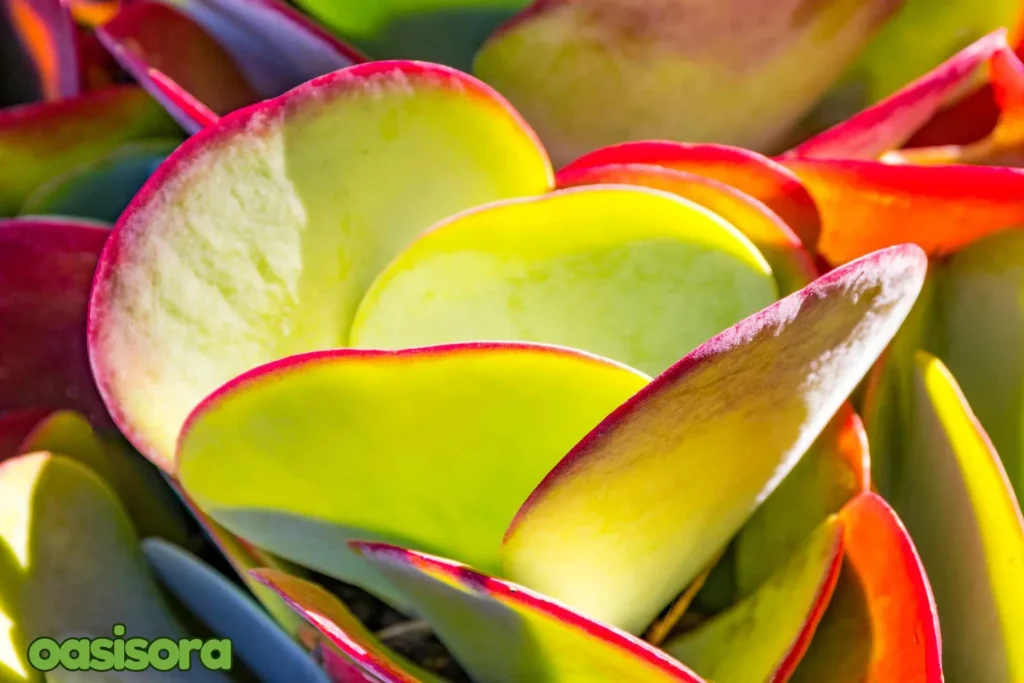
Paddle Plant
Enhance your desert garden with the Paddle Plant!
Its striking, rounded leaves with vibrant red edges make an intense aesthetic appeal.
You can plant this unique beauty in container gardens, rock gardens, or as a border accent in your desert landscapes.
| Native to: | South Africa |
| Climate Regions: | Thrives in Hot Desert (BWh) and Hot Semi-arid (BSh) climates. Can also grow in Cold Semi-arid (BSk) climates with protection from frost. |
| USDA Zones: | 9-12 |
| Pros: | This plant boasts vibrant red edges on its leaves when stressed by the sun, a compact growth habit, and easy propagation. Its modern, sculptural appearance adds a touch of drama to any landscape! |
| Considerations: | This desert plant needs protection from severe frost. Be careful not to overwater it! It also has a special life cycle: the main part of the plant blooms only once and then dies. |
5. Zebra Haworthia (Haworthia fasciata)
AKA: Pearl Plant, Striped Succulent, and Pointed Cushion
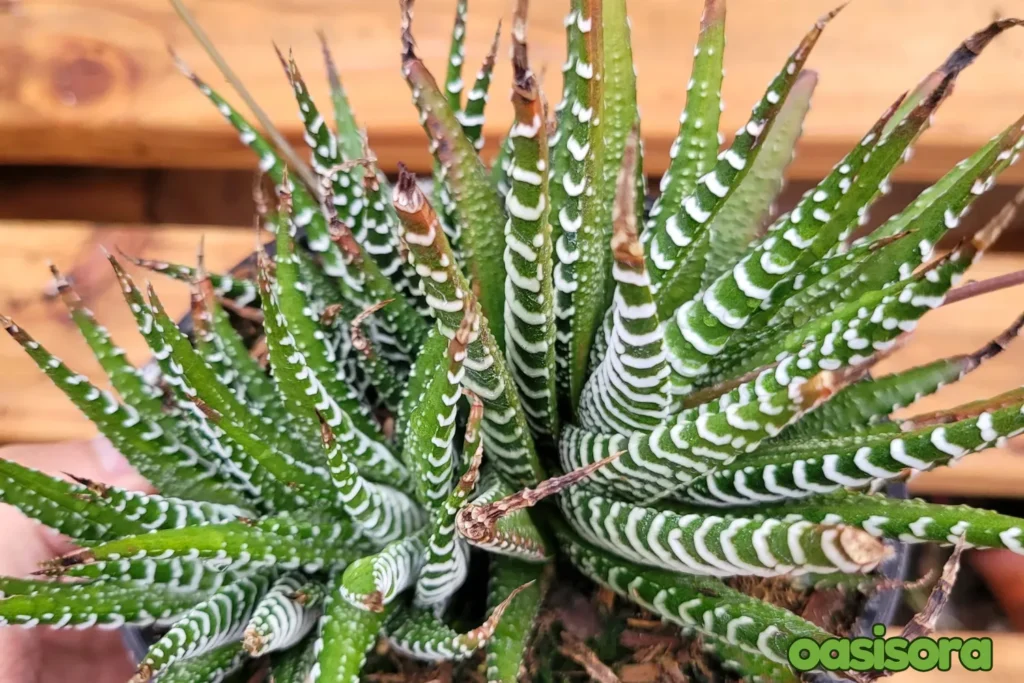
Zebra Haworthia
If you want to add a unique texture to your small spaces or containers, the zebra plant is ideal for you!
It is a charming succulent, featuring striking white stripes, and has compact size makes it ideal for dish gardens or as a decorative accent among larger desert plants.
| Native to: | South Africa |
| Climate Regions: | Thrives in Hot Desert (BWh) and Hot Semi-arid (BSh) climates. With frost protection, it can also grow well in Cold Semi-arid (BSk) climates. |
| USDA Zones: | 9-11 |
| Pros: | It adapts to indoor conditions, boasts stylish white stripes, and easily forms clusters. |
| Considerations: | Give this plant some shade from the strong afternoon sun. Be patient, as it grows slowly. Also, don’t overwater it, as it can be a bit sensitive. |
6. Fairy Castle Cactus (Acanthocereus tetragonus)
AKA: Fairy Castle, Night-Blooming Cereus, and Barbed Wire Cactus

Fairy Castle Cactus
Meet the Fairy Castle Cactus, a real showstopper!
This incredible cactus features lovely flowers that bloom at night and several stems with sharp spines.
It is particularly unique due to its unique growth pattern.
| Native to: | Mexico, Central, and South America |
| Climate Regions: | Thrives in Hot Desert (BWh) and Hot Semi-arid (BSh) climates. With frost protection, it can also grow well in Cold Semi-arid (BSk) climates. |
| USDA Zones: | 9-11 |
| Pros: | This plant can grow up to 6 feet tall, has beautiful, unique stems, and blooms at night with sweet-smelling, colorful flowers. |
| Considerations: | Be careful of the sharp spines! Give it support so the stems don’t get damaged. And don’t overwater – too much water can hurt its roots. |
Flowering Desert Plants for Pops of Color
Let’s beat the desert heat with a splash of color from these gorgeous flowering plants:
7. Desert Marigold (Baileya multiradiata)
AKA: Woolly Desert Marigold, Paper Daisy, Desert Baileya, and Wild Marigold

Desert Marigold
Love the yellow color and want to add sunshine to your hikes?.
Then, try Desert Marigold to brighten up your desert gardens with happy yellow flowers almost all year!.
This flower is great for wild gardens, borders, or natural spaces. It’s stunning when it spreads out and blooms!.
| Native to: | Southwestern United States, Northern Mexico |
| Climate Regions: | Thrives in hot/cold deserts and semi-arid regions (BWh, BWk, BSh, BSk). |
| USDA Zones: | 7-11 |
| Pros: | This flower has many good qualities! It blooms for a long time, spreads easily, and attracts helpful insects. Its bright yellow color is also very cheerful! |
| Considerations: | This flower is short-lived, can look messy, and requires well-draining soil. |
8. Desert Penstemon (Penstemon pseudospectabilis)
AKA: Beardtongue, Beard Tongue, and Desert Beardtongue
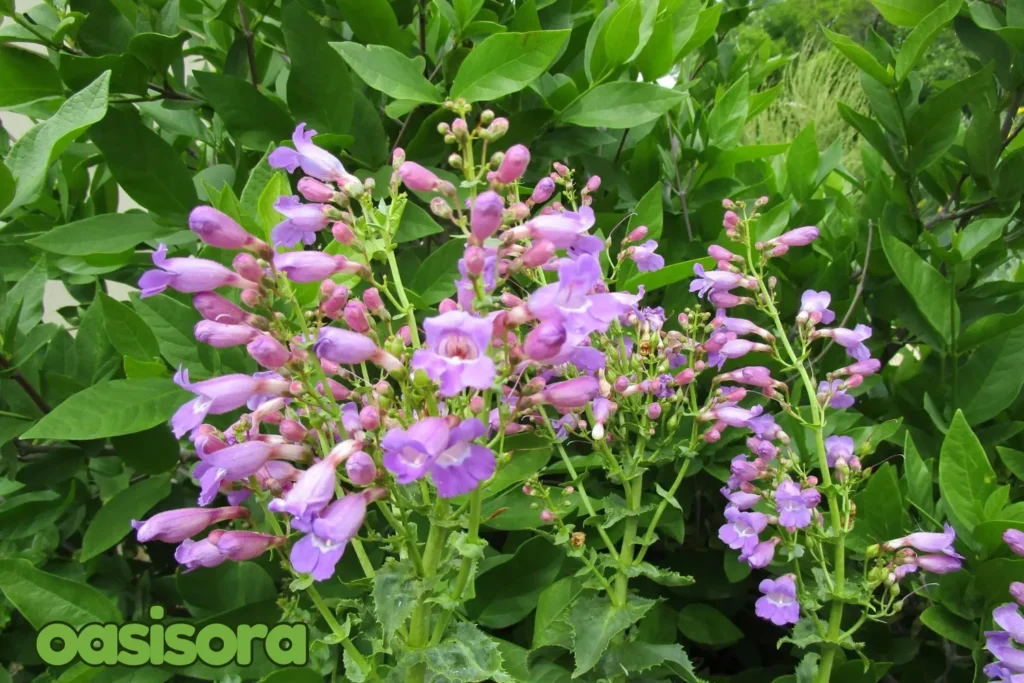
Desert Penstemon
Add a burst of color to your desert garden with these gorgeous wildflowers!.
They develop tall, vibrant spikes that are red, purple, pink, and white in hue. They also give your outside area a dramatic touch and draw in local wildlife!
| Native to: | Sonoran Desert, Mojave Desert |
| Climate Regions: | Hot semi-arid climate (BSh) and Hot desert climate (BWh) |
| USDA Zones: | 5-9 |
| Pros: | These flowers bloom for a very long period and come in an array of shades! They brighten up your garden by drawing butterflies and hummingbirds. |
| Considerations: | Give your desert plants lots of room to breathe to keep them happy and strong. Also, to prevent root damage, do not put them in overly damp or dense soil. |
9. Rock Verbena (Glandularia pulchella)
AKA: South American Vervain, Moss Verbena, Rock Verbena, and Creeping Verbena

Rock Verbena
Transform your outdoor space with this lovely, low-growing plant! It generates bright carpets of color thanks to its clusters of tiny blooms.
Perfect for adding a pop of colour to slopes, rock gardens, or walls, it also beautifully fills gaps between larger desert plants.
| Native to: | Southern Brazil, Uruguay, Argentina |
| Climate Regions: | This plant flourishes in hot semi-arid regions (BSh), cold semi-arid climates (BSk), and hot desert climates (BWh). |
| USDA Zones: | 8-11 |
| Pros: | With its lengthy flowering season, low growth and spreading habit, drought tolerance, and range of colors, this plant is a winner. |
| Considerations: | This desert plant thrives in semi-shaded spots, but needs some upkeep. It may require regular trims to keep its shape, can spread quickly in perfect conditions, and may fade away in extremely hot weather. |
10. Desert Sage (Salvia dorrii)
AKA: Tobacco Sage, Purple Sage, Gray Ball Sage, and Desert Purple Sage

Desert Sage
Suppose you want to add visual appeal and fragrance to your outdoor space.
Then, meet Desert Sage, a stunning compact shrub that’s excellent for the senses!.
This plant has gorgeous silver leaves that smell great! It also produces bright purple flowers that add a burst of colour. It’s perfect for rock gardens, borders, and areas with little water.
| Native to: | Great Basin region |
| Climate Regions: | This plant thrives in various dry climates, including hot and cold deserts and hot and cold semi-arid regions. |
| USDA Zones: | 5-9 |
| Pros: | Its particular silver-gray leaves create a beautiful contrast to your yard, and its fragrant foliage draws pollinators. It’s also incredibly resilient, and easily tolerates heat and drought! |
| Considerations: | This desert plant needs soil that drains well to stay healthy. After a while, it might get a little woody. Cutting it back now and then will help it look its best! |
11. Bush Lantana (Lantana camara)
AKA: Wild Sage, Red Sage, Yellow Sage, and also Spanish Flag

Bush Lantana
If you are looking for a bushy desert plant that is floral and colourful too Bush Lantana is super for you. \
With its constant blooms from spring to fall in various brilliant hues, this flowering shrub is a colour powerhouse!.
An excellent low-maintenance, high-impact accent to your outdoor space, it’s ideal for borders, containers, hedges, or butterfly gardens.
NOTE: Be careful when planting Bush Lantana! It can take over and hurt the environment by pushing out native plants. Ensure it’s native to your area before planting to avoid causing harm.
| Native to: | Americas |
| Climate Regions: | Thrives in hot deserts (BWh) and semi-arid regions (BSh). May need protection in cold deserts (BWk) and cold semi-arid regions (BSk). |
| USDA Zones: | 8-11 |
| Pros: | Gorgeous butterflies are drawn to this colourful desert plant, which blooms continuously in warm weather. It is also quite hardy, and it easily survives drought and heat. |
| Considerations: | It can spread too much in some areas, dies when it gets frosty, and is poisonous if eaten. Handle it with care! |
12. Globe Amaranth (Gomphrena globosa)
AKA: Bachelor’s Button, Button Flower

Globe Amaranth
If you want a colourful, easy-to-care-for flower?.
I’m pretty sure that Globe Amaranth is super for you! Also, they look flawless if you use them in your garden, borders, or pots.
This handsome flower produces many bright purple blooms that attract hummingbirds and butterflies.
| Native to: | Central and South America, Caribbean |
| Climate Regions: | Thrives in hot and semi-arid regions, including tropical and subtropical areas. |
| USDA Zones: | 3-10 |
| Pros: | This flower is fantastic! It blooms in warm weather, attracts beautiful butterflies and hummingbirds, and is easy to care for. |
| Considerations: | It might need stakes to keep it upright, and it spreads quickly by making new seeds. It’s also sensitive to frost, so it can’t handle freezing temperatures. |
Ground Covers & Low-Growing Plants
My folks! Now, say goodbye to humps and hello to a lush, beautiful landscape with these easy-to-grow ground covers and low-growing plants:
13. Ice Plant (Delosperma cooperi)
AKA: Cooper’s Ice Plant, Hardy Ice Plant, Purple Ice Plant, and Trailing Ice Plant

Ice Plant
This stunning, low-growing succulent is a carpet of color!.
This desert plant is a showstopper! Its bright flowers bloom above its thick green leaves, creating a stunning sight. It’s perfect for decorating pathways, rock gardens, and hills.
| Native to: | South Africa |
| Climate Regions: | This plant loves dry climates! It thrives in hot and cold deserts, as well as hot and cold semi-arid regions. |
| USDA Zones: | 6-10 |
| Pros: | This colorful ground cover has beautiful purple-pink flowers, grows quickly, and has cool succulent leaves. |
| Considerations: | In certain places, this plant may become invasive. Also, it needs soil that drains quite well, and it can rot in damp environments. |
14. Bougainvillea (Bougainvillea glabra)
AKA: Lesser Bougainvillea, Paper Flower, Paperflower, and Glory Bower

Bougainvillea
Imagine transforming your outdoor space with this desert plant that adds a vibrant splash of color to your yard!.
Try Bougainvillea! This desert plant comes in amazing colors and can grow up walls or across the ground. It’s perfect for big areas, hills, or walls, and adds a pop of color to any yard!
| Native to: | South America |
| Climate Regions: | Thrives in hot climates, including hot deserts (BWh) and hot semi-arid regions (BSh). |
| USDA Zones: | 9-11 |
| Pros: | This plant has bright colors, grows fast, and is super versatile. You can train it to climb or spread on the ground. Plus, it blooms beautifully for a long time! |
| Considerations: | This plant needs some extra care. It needs to be trimmed often to look its best and stay healthy. It also has sharp stems, so be careful! And, it can’t handle cold weather. |
15. Desert Zinnia (Zinnia acerosa)
AKA: Desert White Zinnia, White Zinnia, Spinyleaf Zinnia, and Wild Zinnia
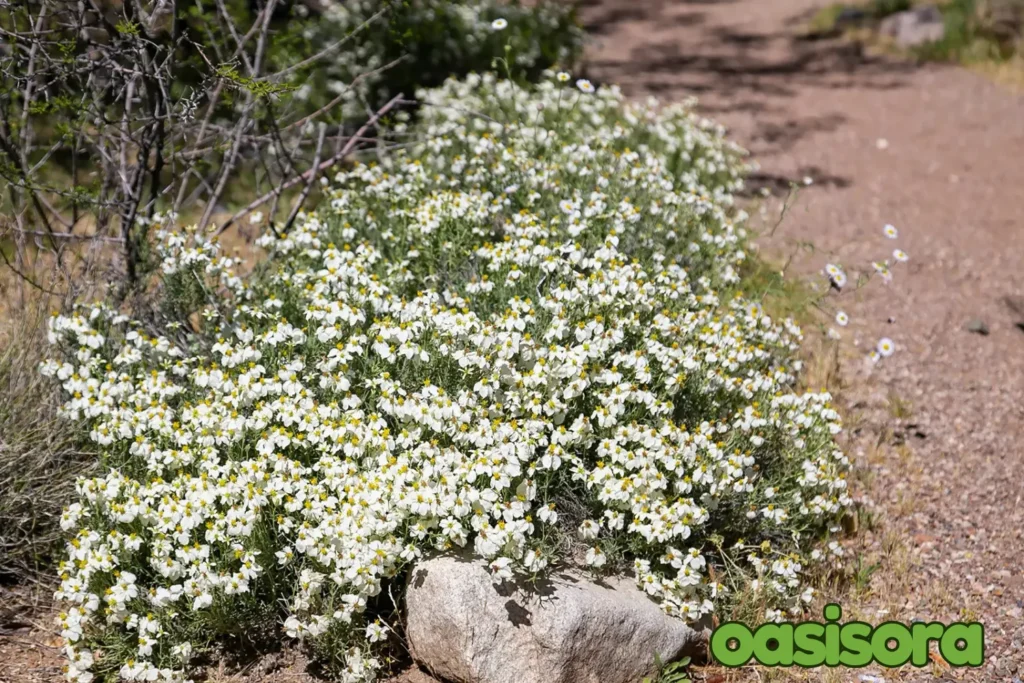
Desert Zinnia
Add a touch of elegance to your desert landscape with this native ground cover!.
It blooms with small white flowers all warm season, making it perfect for rock gardens, filling gaps between larger plants, or showcasing in natural desert plant settings.
| Native to: | Southwestern United States, Mexico |
| Climate Regions: | This ground cover can be difficult to locate, takes a while to establish itself, and thrives best in dry soil. |
| USDA Zones: | 7-10 |
| Pros: | This cute ground cover has white, daisy-like flowers and can survive with very little water. It blooms for a long time and helps local animals because it’s a native plant. |
| Considerations: | This ground cover takes its time to get established, can be hard to find, and prefers lean soil to truly thrive. |
16. Purple Lantana (Lantana montevidensis)
AKA: Weeping Lantana, Trailing Lantana, Small Lantana, and Creeping Lantana

Purple Lantana
Love in with purple color like me?
Consider this Purple Lantana in your desert garden. This lantana spreads widely, producing a dense carpet of white or purple blooms and foliage.
It works well for walls, hanging baskets, and slopes.
| Native to: | South America |
| Climate Regions: | It thrives in hot deserts (BWh) and hot semi-arid climates (BSh), but not in cold deserts (BWk) or cold semi-arid climates (BSk). |
| USDA Zones: | 8-11 |
| Pros: | Spreads wide, blooms constantly in warm weather, and can handle drought. Also great for stopping soil erosion. |
| Considerations: | Be careful as this lantana can take over in some places, dies when it freezes, and is poisonous if eaten. |
17. Red Yucca (Hesperaloe parviflora)
AKA: Hummingbird Yucca, Coral Yucca, False Red Yucca, and Red Hesperaloe
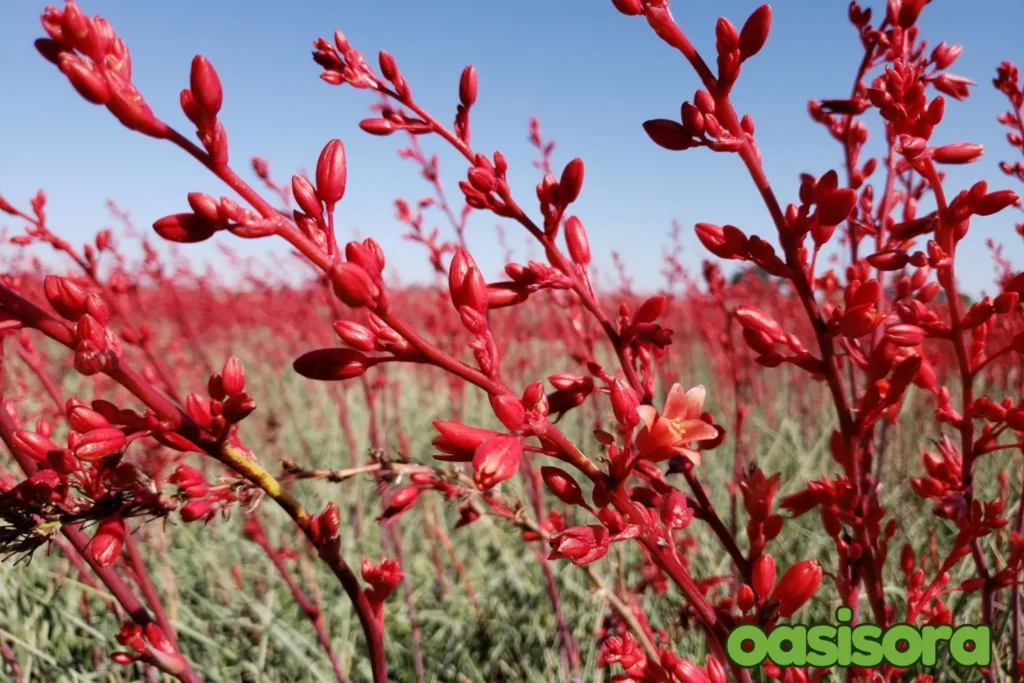
Red Yucca
Don’t let the name of this cool desert plant mislead you this isn’t a real yucca!.
But it’s still magnificent, with curled leaves and towering blossom stalks that look great all year. It’s perfect as a special accent plant or in big groups.
| Native to: | Texas, Mexico |
| Climate Regions: | This plant grows well in arid environments, such as hot and cold deserts and semi-arid areas. |
| USDA Zones: | 5-11 |
| Pros: | This plant is a winner! Long-lasting coral blossoms, hummingbird attraction, year-round green foliage, and minimal maintenance are all features of this plant. |
| Considerations: | It’s a patient plant! When grown from seed, it might take years to bloom, overall grow slowly, and has sharp leaf ends. |
18. Creeping Thyme (Thymus serpyllum)
AKA: Wild Thyme, Pink Thyme, Mother of Thyme

Creeping Thyme
Hey, my friends! Don’t overlook this tiny herb and desert plant in your yard if you have it Creeping Thyme is a low-growing plant that spreads and has small, sweet-smelling leaves.
It produces pinkish-purple flowers all summer. It’s great for:
- Filling spaces between rocks
- Making a fragrant lawn
- Hanging over the edges of pots
| Native to: | Europe, Asia |
| Climate Regions: | This plant thrives in temperate climates with moderate temperatures and rainfall. |
| USDA Zones: | 4-9 |
| Pros: | Creeping Thyme is a super easy-to-care-for plant with pretty flowers that bloom all summer! |
| Considerations: | Be gentle! The thin, fragile leaves and stems of creeping thyme are prone to injury. To keep it under control, it might require routine pruning. |
Architectural Statement Plants
Make a bold impression with these structural stunners:
19. Blue Agave (Agave tequilana)
AKA: Weber’s Blue Agave, Tequila Agave, Mexican Blue Agave, and Weber Azul
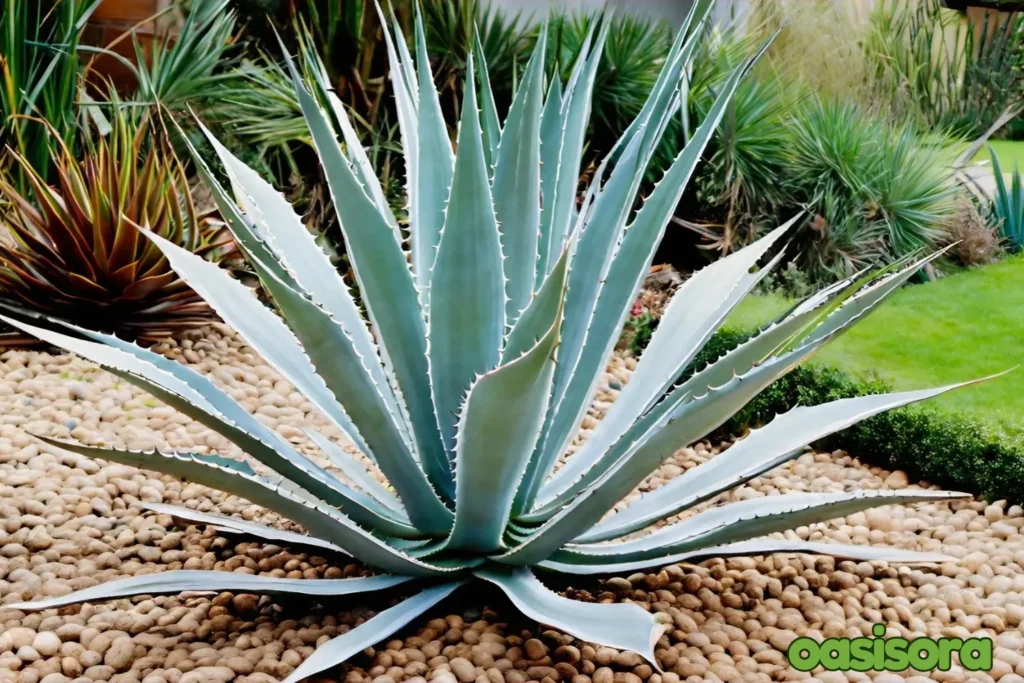
Blue Agave
Meet the superstar of succulents!
This big, beautiful agave plant has stunning gray-blue leaves that can be the centerpiece of your yard. Plus, it’s the plant used to make tequila!.
| Native to: | Mexico |
| Climate Regions: | This agave loves hot weather and does well in hot deserts and semi-arid regions. It can survive in cold areas but needs extra protection. |
| USDA Zones: | 9-11 |
| Pros: | It has a striking blue-gray hue, a remarkable shape, and a long lifespan. It is also very low maintenance and drought tolerant. |
| Considerations: | This desert plant has a short but dramatic life span—it flowers once and then dies, but not before existing for a good ten to fifteen years—and it becomes incredibly large. You should be wary of its stinging spines. |
20. Organ Pipe Cactus (Stenocereus thurberi)
AKA: Arizona Organ Pipe, Pitaya Dulce, Sweet Pitaya, and Desert Organ Pipe
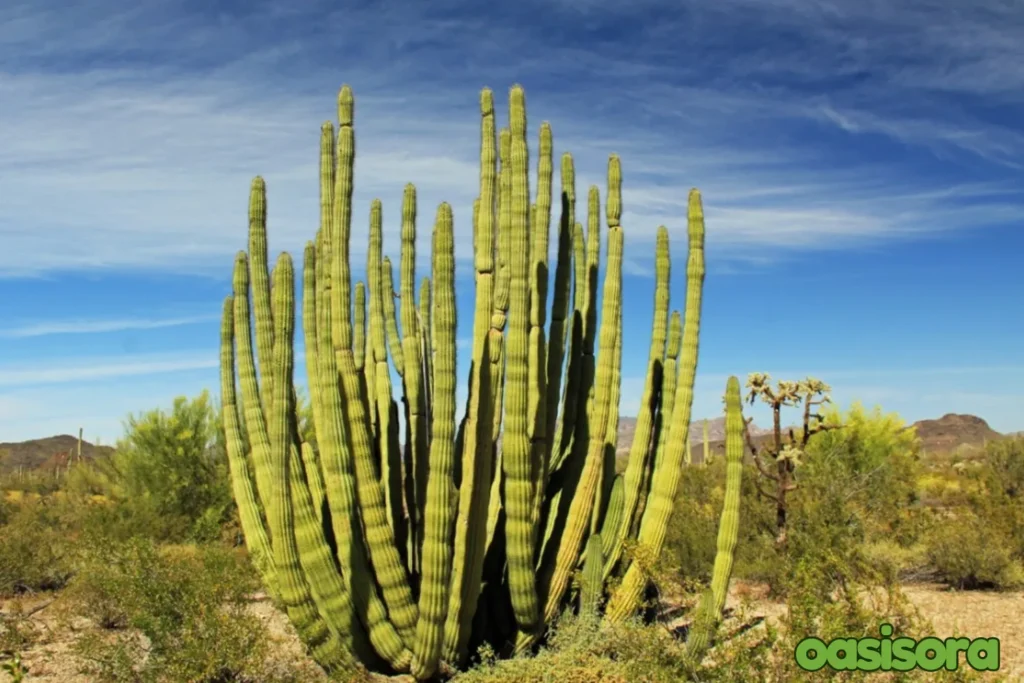
Organ Pipe Cactus
With this gorgeous multi-stemmed cactus, you may add some sort of spectacle to your surroundings!.
As it develops into a natural sculpture, it produces an amazing vertical show with tall columnar stems rising from a single base.
| Native to: | Sonoran Desert |
| Climate Regions: | Thrives in Hot semi-arid climate (BSh); hot desert climate (BWh), not suitable for Cold semi-arid climate (BSk) or Cold desert climate (BWk) |
| USDA Zones: | 9-11 |
| Pros: | It grows in a unique columnar style, yields tasty edible fruit, endures for many years, and gives any landscape striking vertical interest. |
| Considerations: | This desert plant grows slowly, needs room to spread out, and doesn’t like frost, so it needs a little extra care. |
21. Totem Pole Cactus (Pachycereus schottii f. monstrosus)
AKA: Whisker Cactus, Monstrose Senita, Monstrose Totem, and Smooth Senita

Totem Pole Cactus
Discover the fantastic beauty of this rare, spineless Senita Cactus! Its smooth, wavy columns create a breathtaking sculptural element, perfect as a dramatic focal point in your modern desert garden.
Each one is a unique work of art, like abstract sculpture.
| Native to: | Baja California, Mexico |
| Climate Regions: | Thrives in hot deserts and semi-arid regions, but not suitable for cold climates. |
| USDA Zones: | 9-11 |
| Pros: | This cactus has cool, smooth stems with no sharp points. It looks very modern and can grow up to 12 feet tall! |
| Considerations: | Slow-growing, sensitive to frost, needs afternoon sun protection when young, and can come with a higher price tag. |
22. Ocotillo (Fouquieria splendens)
AKA: Vine Cactus, Coachwhip, Jacob’s Staff, Desert Coral, and Candlewood

Ocotillo
Want to know the secret to making your yard a stunning relaxing spot? It’s the Ocotillo desert’s hidden gem!
This cool desert plant cactus has tall, prickly stems that grow leaves after rain and show off bright red flowers. It adds a wow factor to any landscape!.
| Native to: | Southwestern United States, Mexico |
| Climate Regions: | Thrives in cold semi-arid climates (BSk), hot semi-arid climates (BSh), and cold desert climates (BWk). |
| USDA Zones: | 8-11 |
| Pros: | Wow, this plant is a real superstar! It grows in a cool, unique way that’s sure to grab your attention. And, it yields bright red flowers to attract hummingbirds and also looks remarkable! |
| Considerations: | This fabulous plant is too difficult to relocate, has sharp needles, and loses its leaves when it becomes too dry. |
23. Desert Spoon (Dasylirion wheeleri)
AKA: Spoon Flower, Common Sotol, Wheeler Sotol, and Desert Candle
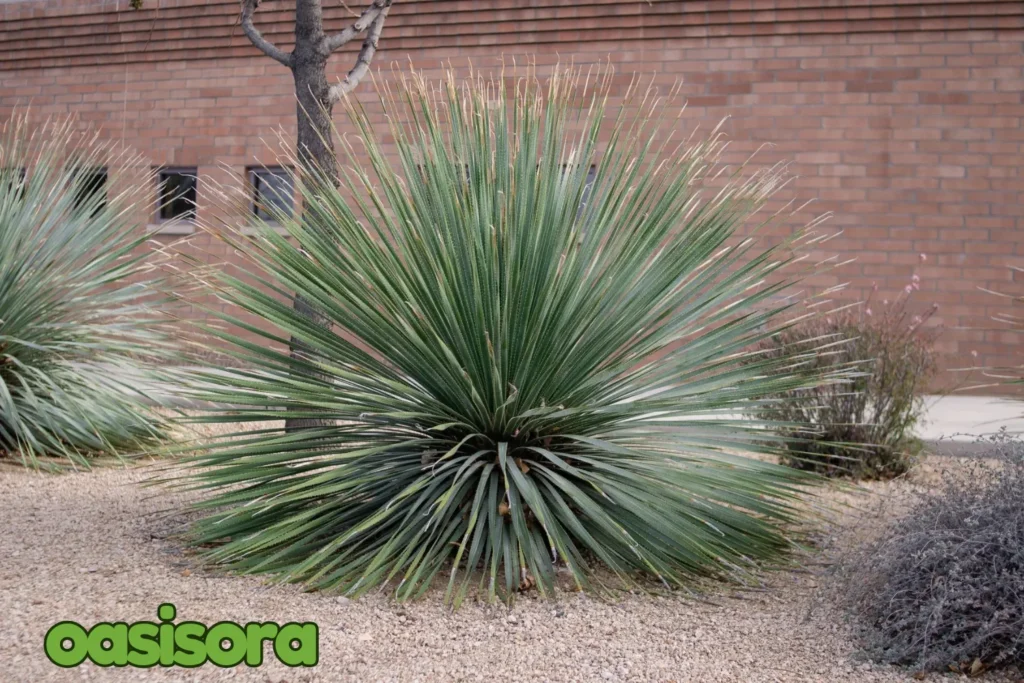
Desert Spoon
With the spectacular Desert Spoon, you can add a touch of class to your desert garden!.
This incredible desert plant boasts a unique spherical shape, covered in striking blue-gray leaves. Perfect as a solo statement piece or grouped together for maximum impact.
So, try it and get ready to elevate your outdoor space!.
| Native to: | Southwestern United States, Mexico |
| Climate Regions: | It thrives in Cold desert climate (BWk), hot desert climate (BWh), Cold semi-arid climate (BSk), and also hot semi-arid climate (BSh) |
| USDA Zones: | 8-11 |
| Pros: | It’s a symmetrical, long-lived, evergreen, and drought-tolerant plant. |
| Considerations: | This stunning plant has some special needs! Its beautiful leaves have sharp edges, so handle with care. It’s also a slow grower, so be patient. And guys don’t forget to give it ample space to display its exceptional beauty! |
24. Joshua Tree (Yucca brevifolia)
AKA: Yucca Palm, Tree Yucca, and also Palm Tree Yucca
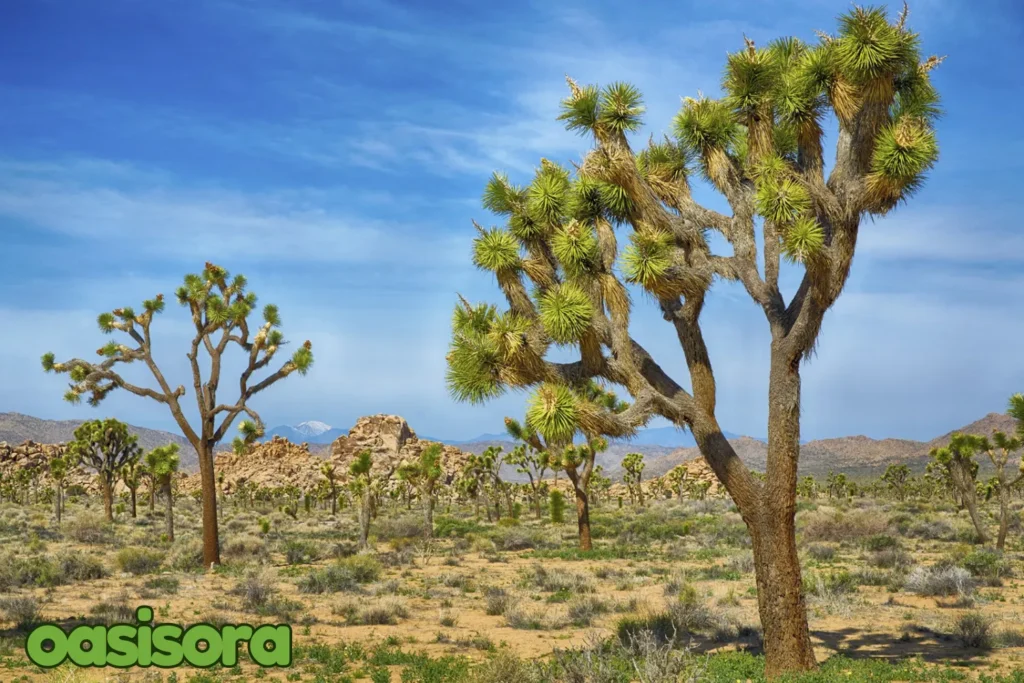
Joshua Tree
Improve your yard’s look with a touch of modesty with the iconic Joshua tree!.
This incredible tree boasts a unique, tree-like shape, covered in striking green leaves. Perfect as a solo statement piece or grouped for maximum impact.
| Native to: | Mojave Desert, southwestern United States |
| Climate Regions: | It thrives in Cold desert climate (BWk) and hot desert climate (BWh) |
| USDA Zones: | 6-10 |
| Pros: | This tree is super pretty and perfectly shaped! It adds a touch of class to any yard. It grows slowly, so you don’t need to trim it often. And, it stays green all year round, looking beautiful even when it’s dry outside! |
| Considerations: | This desert plant has sharp leaves, needs space to grow and can grow quite tall (up to 40 feet)! |
Native Desert Plants for Natural Beauty
Now, let’s read about the breathtaking beauty of these desert plants at your doorstep:
25. Brittlebush (Encelia farinosa)
AKA: White Brittlebush, Incienso, Goldenhills, and Desert Gold
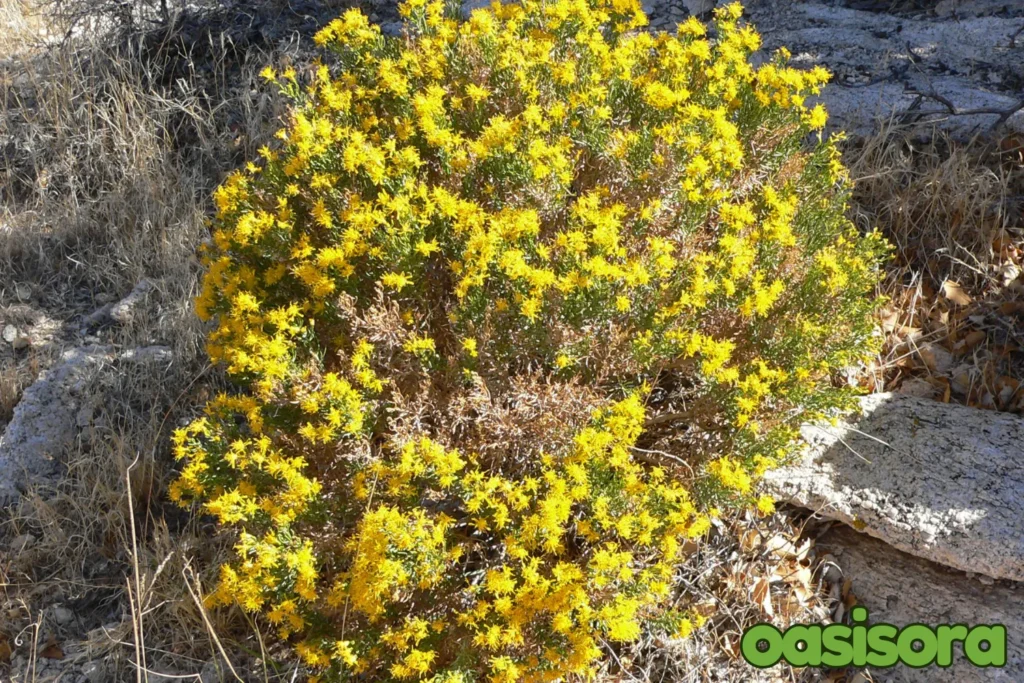
Brittlebush
Include this stunning silver-leaved shrub for the fabulous bush that explodes with bright yellow, daisy-like flowers every spring.
Also, it attracts butterflies and adds a touch of desert charm to your garden with this gorgeous, low-maintenance beauty.
| Native to: | Southwestern United States, Mexico |
| Climate Regions: | It prospers in hot deserts (BWh), cold desert landscapes (BWk), and warm semi-arid regions (BSh). |
| USDA Zones: | 8-11 |
| Pros: | This plant has happy yellow flowers and shiny silver leaves. It grows quickly and brings in bees and butterflies. It’s a wonderful plant to have in your garden! |
| Considerations: | This plant has a short life and can look a bit messy in summer. To keep it looking nice, you need to trim it often. This helps it grow new parts and stay neat. |
26. Desert Lupine (Lupinus sparsiflorus)
AKA: Coulter’s Lupine, Mojave Lupine, Desert Blue Bonnet, and also Arizona Lupine
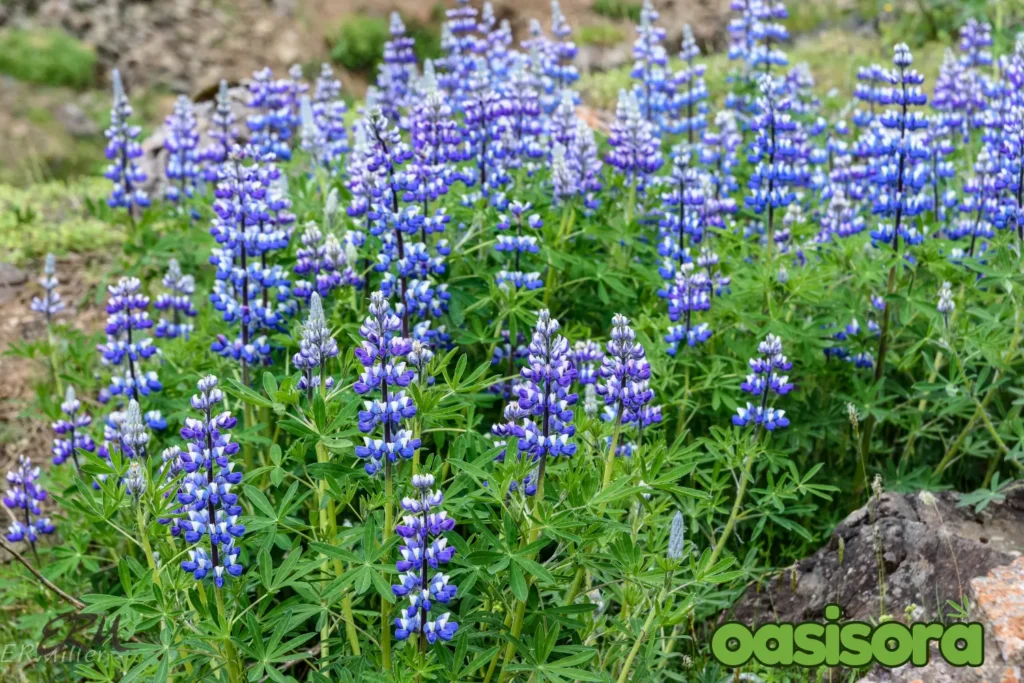
Desert Lupine
Check out this amazing purple-blue flower!.
It blooms in spring and is perfect for gardens with wildflowers or natural landscapes.
| Native to: | Southwestern United States |
| Climate Regions: | It is supreme to flourish in hot deserts (BWh), cooler desert landscapes (BWk), warm semi-arid climes (BSh), and cooler semi-arid regions (BSk). |
| USDA Zones: | 4-10 |
| Pros: | Its stunning blue blooms draw pollinators and provide native regions with a sophisticated touch. |
| Considerations: | This desert plant needs a little extra love. It only lives for a year and needs winter rain to grow. If it’s too dry, it might not bloom. |
27. Apache Plume (Fallugia paradoxa)
AKA: Rock Rose, Ponil, False Feather, and Desert Apache Plume
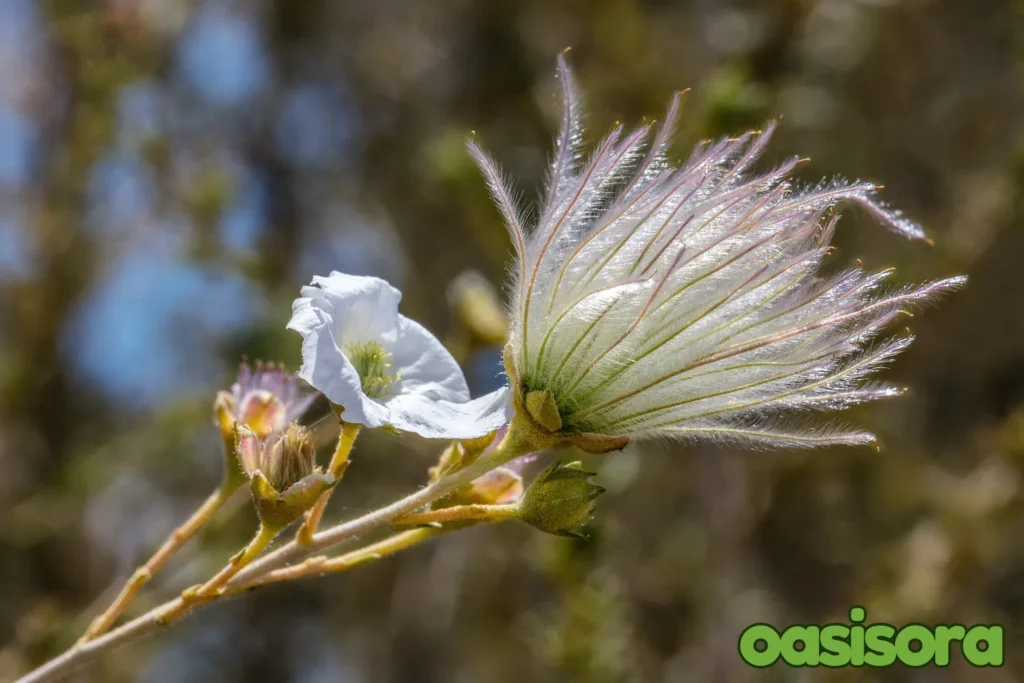
Apache Plume
Folks! Like me, do you adore matching pink and white?.
If yes, then this native shrub is a dynamic addition to your garden. It offers a splendid display of white flowers followed by delicate, feathery pink seed plumes
It’s a great option for you if you love both gardening and the natural world, as it offers multi-season interest and also an important habitat for your nearby species!.
| Native to: | Southwestern United States |
| Climate Regions: | From the harsh temperatures of hot and cold deserts (BWh and BWk) to the milder circumstances of hot and cold semi-arid regions (BSh and BSk), this hardy shrub thrives in a variety of climates. |
| USDA Zones: | 4-10 |
| Pros: | This native shrub is a treasure trove of delights, boasting beautiful white flowers, decorative seed plumes that add texture and interest, and a long blooming season that provides a constant source of beauty and wildlife value. |
| Considerations: | This plant needs good drainage. It grows slowly and can look messy if you don’t trim it. |
28. Desert Globemallow (Sphaeralcea ambigua)
AKA: Desert Globemallow, Apricot Mallow, Sore Eye Poppy, and Desert Hollyhock

Desert Globemallow
Folks! Meet this stunning native desert shrub, whose gray-green foliage wonderfully complements its brilliant orange blooms.
This lovely, low-maintenance desert shrub will draw butterflies and give your natural garden a splash of color.
| Native to: | Southwestern United States |
| Climate Regions: | This plant is built to withstand harsh climates, thriving in hot and cold deserts, as well as hot and cold semi-arid regions, making it a great choice for easy, low-maintenance gardening! |
| USDA Zones: | 6-10 |
| Pros: | This plant is a vibrant delight! This plant has bright orange flowers that bloom for a long time! It’s also super good at surviving without much water, making it perfect for gardens that need little care. Plus, it attracts pollinators! |
| Considerations: | This plant can quickly propagate itself and has a shorter lifespan. It may also appear a little messy at times, but the lovely blossoms make it ideally aesthetic! |
29. Wolfberry (Lycium pallidum)
AKA: Pale Wolfberry, Pale Desert-Thorn, Desert Thorn, and Rabbit Thorn
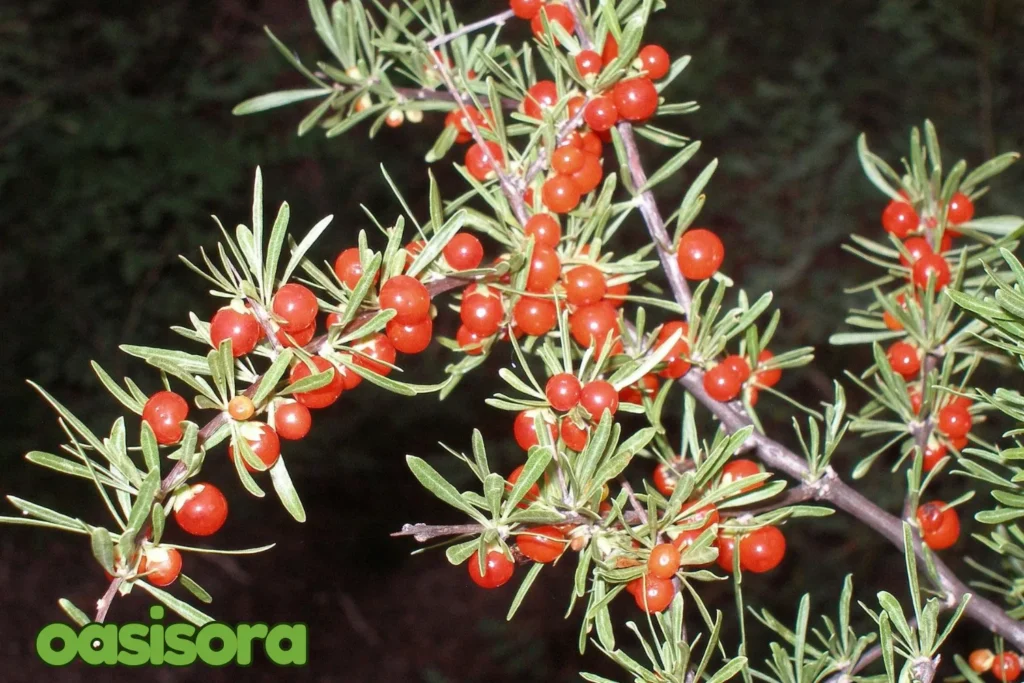
Wolfberry
Are you ready to taste nature’s gift in your yard? Then, plant wolfberry in your garden.
This shrub is a cozy home for animals and birds. It grows yummy berries that birds, bees, and butterflies love. It’s great for making a natural fence for your garden and wildlife!.
| Native to: | Southwestern United States |
| Climate Regions: | This desert plant grows well in hot semi-arid climates (BSh), cold semi-arid climates (BSk), and cold desert climates (BWk). |
| USDA Zones: | 7-10 |
| Pros: | This shrub is a superstar! It produces delicious Goji berries, supports local wildlife, and can thrive in dry conditions. Plus, its dense growth makes it an outstanding natural barrier. |
| Considerations: | This shrub can spread out and grow in new places. It has prickly branches and drops its leaves in winter. |
30. Mesquite Tree (Prosopis glandulosa)
AKA: Mesquite, Algarrobo

Mesquite Tree
Ready to Relax under the majestic Honey Mesquite tree, my dears!. This natural tree attracts birds, bees, and butterflies with its tasty bean pods, making it a wildlife paradise.
It thrives in dry environments and offers royal shade, making it ideal for naturalistic landscapes or wildlife-friendly gardening.
| Native to: | Southwestern United States, Northern Mexico |
| Climate Regions: | Thrives perfectly in the hotter desert climates (BWh), Cold arid climate (BWk), hot semi-arid climates (BSh), and Cold semi-arid climates (BSk) |
| USDA Zones: | 8–11 |
| Pros: | This tree is a rockstar! It produces delicious bean pods, supports local wildlife, and can thrive in dry conditions. Plus, its majestic canopy provides excellent shade. |
| Considerations: | This tree has thorny branches, sheds its leaves in winter, and can spread beyond its original spot through underground suckers. However, it is worth a bit more attention due to its numerous advantages. |
Desert Trees & Shrubs for Shade and Structure
Next, let’s have a look at the perfect desert plants to bring shade, structure, and beauty to your outdoor oasis:
31. Creosote Bush (Larrea tridentata)
AKA: Greasewood, Chaparral, Gobernadora, and Hediondilla

Creosote Bush
The Creosote Bush is a very slow-growing evergreen desert plant having dark greenish leaves and remarkable yellowish flowers. Due to its deeper roots, it thrives in full sun and tolerates drought. This plant prefers well-draining soil but adapts to little rocky, saline, or alkaline conditions. It reproduces by seed and roots, forming clonal rings that can live up to approximately 11,000 years.
This bush looks great against plain backgrounds, and that makes it a great choice for desert landscapes with its matchless shape and hardiness.
| Native to: | Southwestern United States or Northern Mexico |
| Climate Regions: | Usually grow well in hot desert climates (BWh), Cold arid climates (BWk), hot semi-arid climates (BSh), and also Cold semi-arid climates (BSk) |
| USDA Zones: | 8-11 |
| Pros: | This bush is a low-maintenance plant, extremely drought-tolerant, requires minimal care, and can live for hundreds of years. Plus, also a nice choice for wildlife-friendly gardening, as it offers food and shelter for many creatures. |
| Considerations: | Creosote Bush can unfortunately become leggy if you don’t prune it regularly, and its resin can be really messy. However, its perks are more than its minor drawbacks. |
32. Yellow Palo Verde (Parkinsonia microphylla)
AKA: Foothill Palo Verde
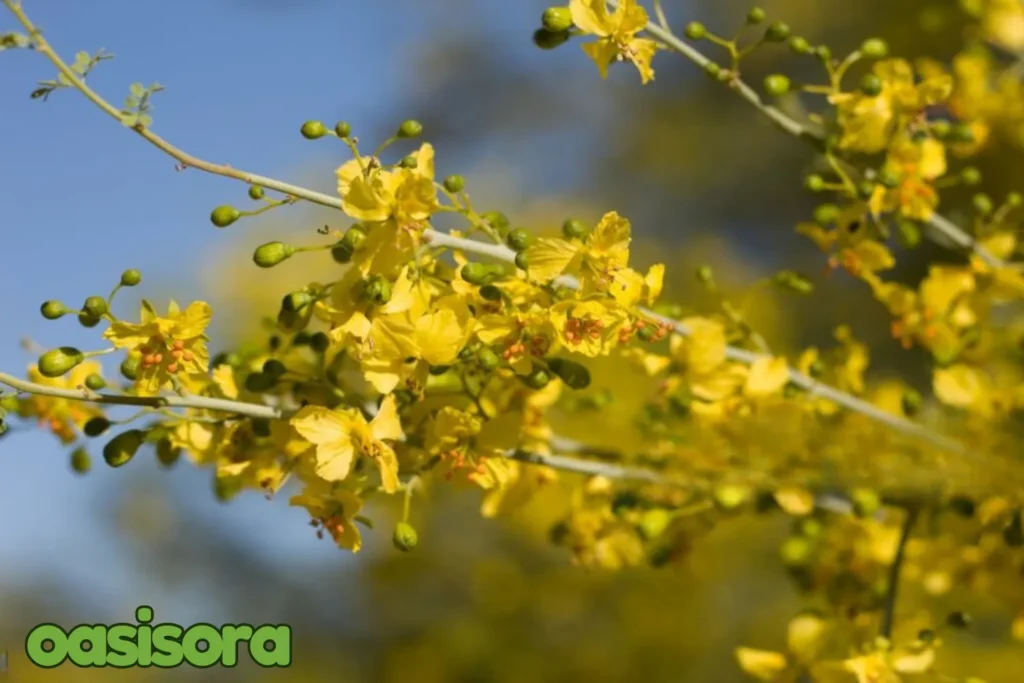
Yellow Palo Verde (parkinsonia)
Are you ready to shine with the Yellow Palo Verde? This desert plant is a remarkable species that thrives in harsh conditions. Its slow growth and upright branches allow it to live for centuries, reaching heights of up to 5 meters roundly. When the heat becomes intense, it sheds the leaves, but its green bark takes over, photosynthesising and keeping it alive. It has delicate yellow flowers that may bloom if the rains have been kind.
It’s a challenging start for young seedlings, with only a tiny fraction surviving the harsh conditions. Still, this tree’s adaptability makes it a true desert gem.
| Native to: | Southwestern US or Mexico (Northern) |
| Climate Regions: | Can thrive well in hot desert climates (BWh), colder arid climates (BWk), hot semi-arid climates (BSh), and Cold semi-arid climates (BSk), too. |
| USDA Zones: | 8-11 |
| Pros: | Have vibrant yellow flowers, drought tolerance, excellent shade, wildlife support, low maintenance, are adaptable to harsh conditions, and long lifespan. |
| Considerations: | This can be sensitive to frost, so it’s vital to plant it in a space with some protection. It also requires occasional pruning to maintain its shape. |
33. Desert Lavender (Condea emoryi)
AKA: Hyptis emoryi
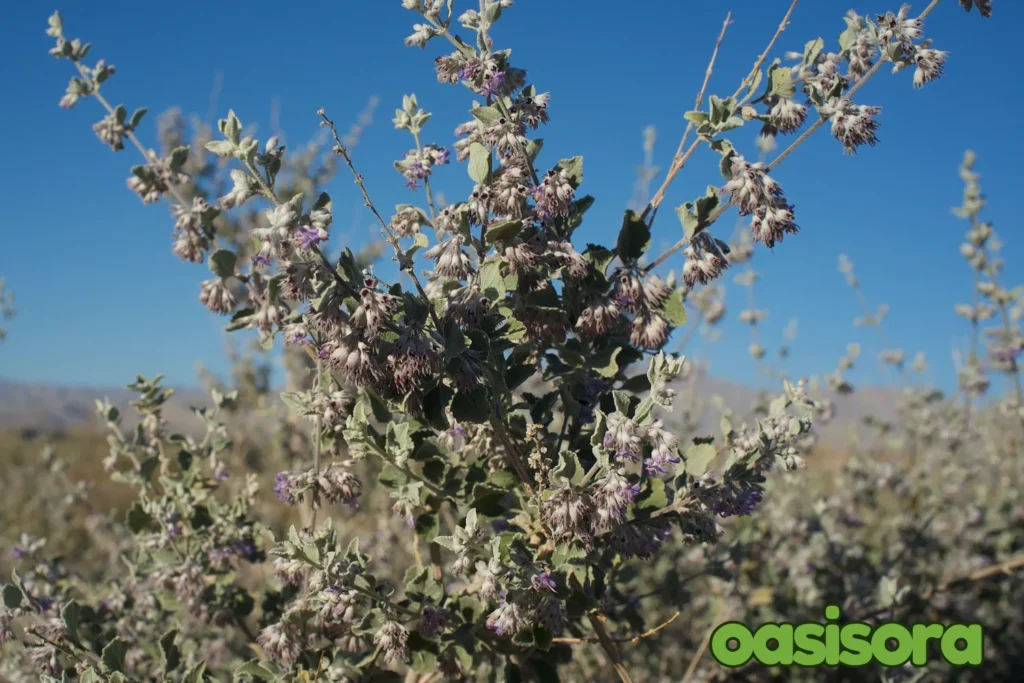
Desert Lavender
Desert lavender is one of those desert plants that makes you smile. Its silvery leaves and purple flowers are a perfect combo, and the nice thing about it is that it blooms almost all year round. The fuzzy texture of this plant is excellent, too, and it grows into a pretty cool bush. Plus, its low maintenance, you just give it some sun and a good soil mix, and it’s decent to go. It needs a little water in the summer.
You can shape it into a hedge if you want, and it’s a total pollinator magnet. Further, Deer don’t seem to bother with it much either.
| Native to: | Southwestern United States and Northern Mexico |
| Climate Regions: | Hot desert climates (BWh) or hot semi-arid climates (BSh) |
| USDA Zones: | 8-11 |
| Pros: | It’s a low-maintenance gem, drought-tolerant, requires your little care, and attracts pollinators like bees and butterflies. Plus, its fragrant flowers are also a bonus for your yard. |
| Considerations: | This lavender can be sensitive to frost plus may require protection during harsh winters. It also needs occasional pruning to maintain its shape. |
34. Oleander (Nerium oleander)
AKA: Rosebay, Kaner, or Adelfa

Oleander
Oleander is a remarkable shrub that can bring life to your desert gardens with its cute plus bright flower clusters in pink, white, red, yellow, and peach. Its blooms stand out against sleek green leaves and last from late spring to early fall. That’s so unique! Plus, the leafy vegetation adds a tropical touch all year. Hardy and versatile, oleander’s perfect for warm climates, adding colour and texture to any landscape.
| Native to: | Mediterranean region |
| Climate Regions: | Hot desert climates (BWh) and mid-hot semi-arid climates |
| USDA Zones: | 8-11 |
| Pros: | A drought-tolerant desert plant, heat-tolerant, requires minimal care, and harvests showy flowers. It’s also a great choice for hedges or screens. |
| Considerations: | The Oleander Nerium plant is too toxic if ingested. So keep this in mind! It’s crucial to handle it with care and keep it out of reach of your children and pets. Plus, offer it occasional pruning to maintain its shape. |
Ornamental Desert Grasses for Texture & Movement
Now, we are going to discuss some grasses for your yard’s texture and movement:
35. Pink Muhly Grass (Muhlenbergia capillaris)
AKA: Sweetgrass
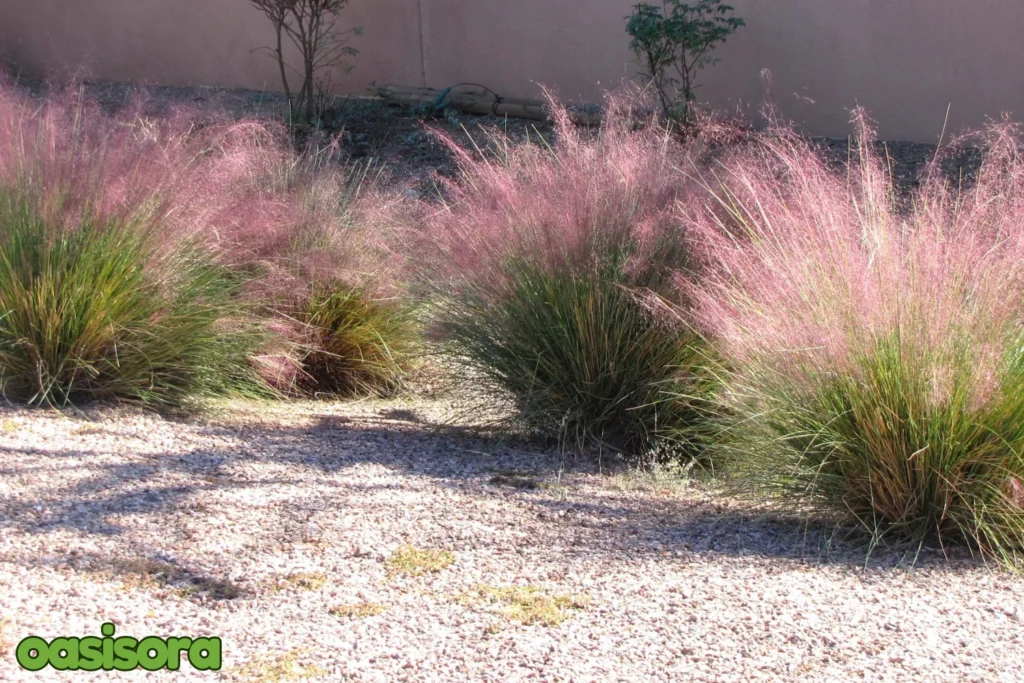
Pink Muhly Grass
Pink Muhly Grass is a really wonderful ornamental grass. It forms a cloud of vibrant pink flowers in fall, resembling cotton candy. The airy inflorescences of it float above its dark green, finely textured leaves. It remains attractive even in winter and is ideal for hot, dry climates. Perfect for adding late-season interest to gardens when planted in groups.
| Native to: | Southeastern United States |
| Climate Regions: | Hot semi-arid climates |
| USDA Zones: | 7-10 |
| Pros: | This desert grass is low maintenance, effortless to care for, and can add good-looking texture and movement to your yard. Plus, it also attracts pollinators with a nice pinkish shade in fall, and is deer resistant. |
| Considerations: | This plant needs irregular pruning, favors well-drained soil, and might need some defense in extreme weather |
36. Little Bluestem (Schizachyrium scoparium)
AKA: Beardgrass and Andropogon scoparius usually

Little Bluestem
Little Bluestem is an awesome and stunning desert grass with vibrant fall colors and fluffy seed heads. Its stems turn aesthetic copper, orange, and reddish shades over time. This adds ornamental value and also aids wildlife. The seed heads of this grass offer food for small birds in winter. This makes it good for wildlife-friendly yards. So, you must pick it if you want to add beauty and wildlife support to your yard.
| Native to: | North America |
| Climate Regions: | Hot semi-arid climates, Cold semi-arid climates |
| USDA Zones: | 3-9 |
| Pros: | Ornamental value, wildlife-friendly, adaptable, drought-tolerant, low maintenance |
| Considerations: | May require occasional pruning, can be sensitive to overwatering |
Rare & Unique Desert Plants for Collectors
Lastly, let’s have a look at the rare and matchless desert yard plants:
37. Pencil Cactus (Euphorbia tirucalli)
AKA: Indian Tree Spurge, Milk Bush, Pencil Tree, Finger Tree, Aveloz, or Petroleum Plant

Pencil Cactus
Pencil Cactus is a cool succulent with bright colors and fun growth. Its stems turn red, orange, and yellow, making gardens look awesome. It’s great for modern gardens and dry landscapes. Designers love it for adding a special touch and making succulent arrangements. It’s perfect for pots and adding color.
| Native to: | Africa and India |
| Climate Regions: | Hot desert climates |
| USDA Zones: | 9-11 |
| Pros: | Unique shape, drought-tolerant, low maintenance |
| Considerations: | Toxic sap, needs protection from frost |
38. Rock Purseland (Calandrinia grandiflora)
AKA: Cistanthe

Rock Purseland
Rock Purseland is a beautiful plant with vibrant flowers. This alluring succulent desert plant boasts blue-green leaves and bright colored flowers that add charm and beauty to gardens, attracting pollinators and making them more vibrant.
| Native to: | South America |
| Climate Regions: | Hot semi-arid climates |
| USDA Zones: | 8-10 |
| Pros: | This plant has beautiful, appealing flowers, is drought-tolerant, and is also a low-maintenance plant |
| Considerations: | It needs good drainage, and is usually sensitive to frost |
39. El Niño Desert Orchid (Chitalpa hybrid)
AKA: Desert Orchid or Catalpa

El Niño Desert Orchid
El Niño is a beautiful, multibranched tree or shrub with fragrant flowers. It grows really fast and blooms all summer. You can cut it to keep it in shape or let it grow bigger, as you wish. It loves full sun due to heat and drought-tolerance, plus, it requires little care.
| Native to: | Hybrid |
| Climate Regions: | Hot desert climates |
| USDA Zones: | 6-9 |
| Pros: | Has showy flowers, is drought-tolerant, and is low maintenance |
| Considerations: | This desert plant needs occasional pruning, and it is also sensitive to extreme temperatures |
How to Incorporate Desert Plants Into Your Landscape
Now, as you have learned all about the plants that you can add to your desert yard. So, let me tell you how to add them:
1. Designing a Balanced Desert Garden
Folks! Do remember, creating a stunning desert garden is all about balance! You should combine different textures, heights, and colors to craft a visually appealing oasis. Think smooth cacti, fuzzy succulents, and delicate wildflowers, all working together in harmony.
2. Xeriscaping Basics
Xeriscaping is all about efficient water use! In this method, you have to group plants by their water needs to minimize waste and maximize beauty. Start with drought-tolerant plants like succulents and cacti, and pair them with water-wise groundcovers and ornamental grasses.
3. Desert Plants in Containers
Bring the desert charm to your patio or small space with container gardening! Choose compact desert plants like aloe, agave, or yucca, and pair them with decorative pots and planters. They are perfect for adding a touch of the desert to even the smallest areas!
Care and Maintenance of Desert Plants
Of course! Caring for these plants is also crucial to keeping them in good shape and health. For this keep the following desert plant care points in mind:
1. Soil and Watering Tips
Desert plants need well-draining soil and careful watering! Use a potting mix made specifically for cacti and succulents, and water them carefully, letting the soil dry out between applications.
2. Seasonal Care
Adjust your care routine with different seasons! In summer, provide them with shade and extra water. In winter, reduce watering and protect them from frost.
3. Pest and Disease Management
Watch out for diseases and pests in your desert yard! Examine your plants frequently, remove any diseased or damaged parts, and apply fungicides or insecticidal soap as necessary.
Final Thoughts
Bring the Desert’s Beauty Home
Charm your yard with the beauty of the desert plants!.
Whether you have a cozy balcony or a spacious backyard, desert flowers are perfect for creating a stunning and eco-friendly space!
Check out our desert landscape ideas for inspiration to incorporate these resilient plants into your next garden project.
The desert plants are superheroes. They’ve adapted to survive in extreme conditions with cool tricks like waxy coatings, water-storing powers, and deep roots.
We’re teaming up with nature by welcoming these champs into our gardens to create breathtaking landscapes that save water.
Try nature’s beauty right in your yard today!
FAQs
1. What kind of plants live in the desert?
The plants that perfectly flourish in desert areas:
Succulents
Wildflowers
Cacti
Aloe Vera.
2. What is the prettiest desert flower?
The Desert Marigold is one of the most beautiful desert flowers.
3. What is the best desert plant?
The Saguaro Cactus is the best plant in the desert as it is iconic, has low maintenance, and provides a home for desert wildlife.
4. What are the best bushes for the desert?
Texas Sage and Desert Willow are top desert bushes.

7 thoughts on “39 Best Desert Plants to Beautify Your Home and Garden”
Comments are closed.